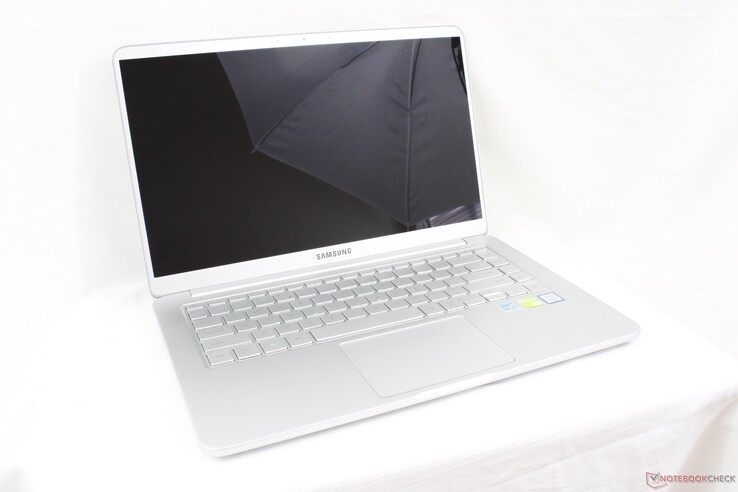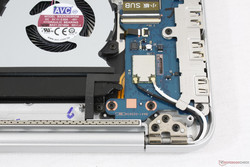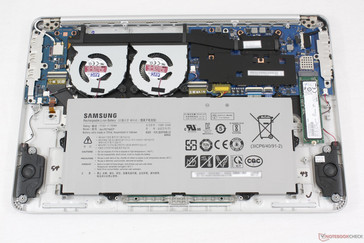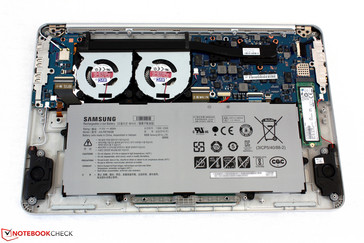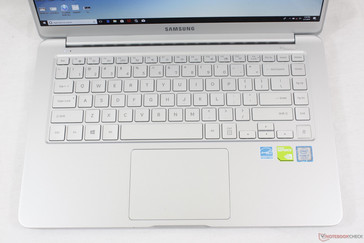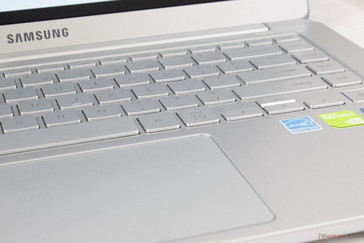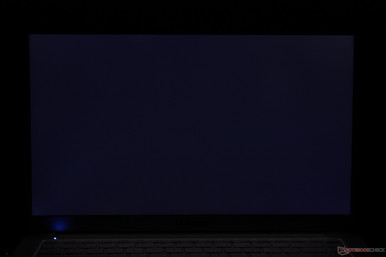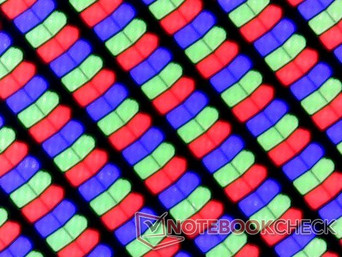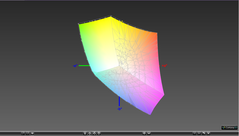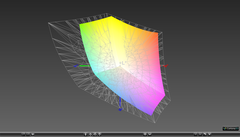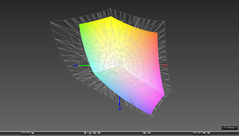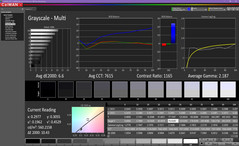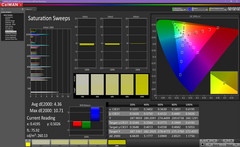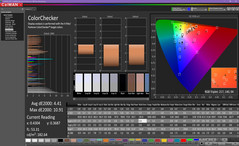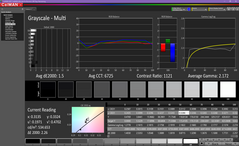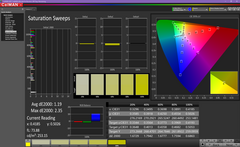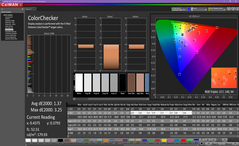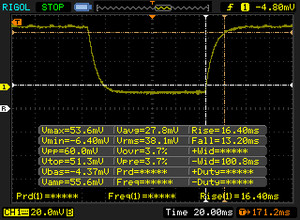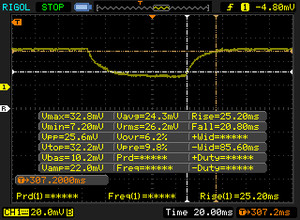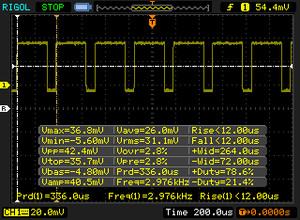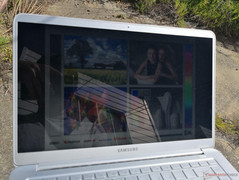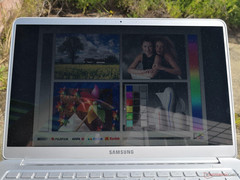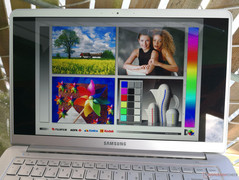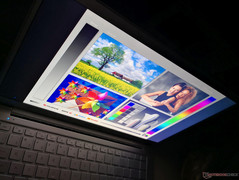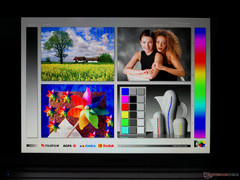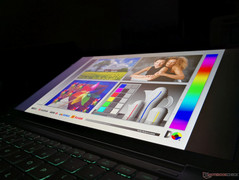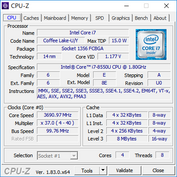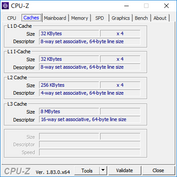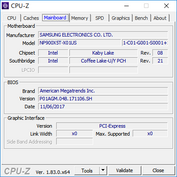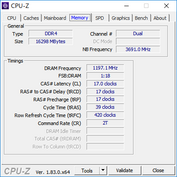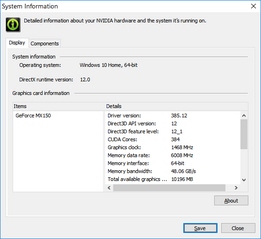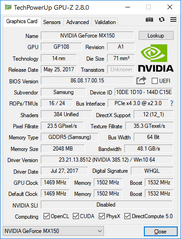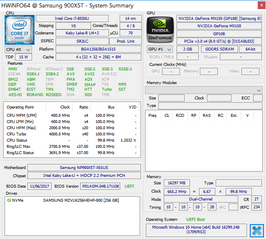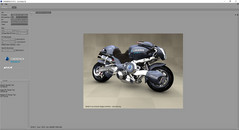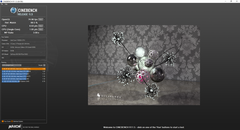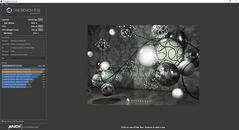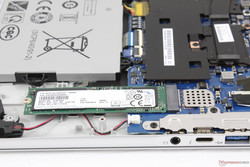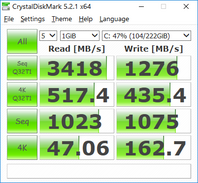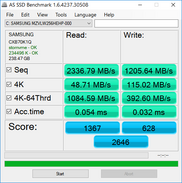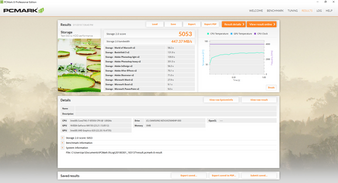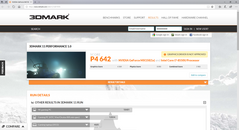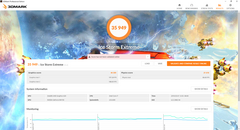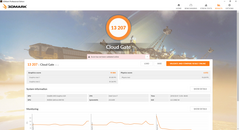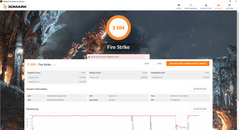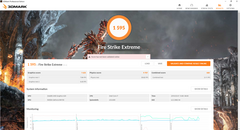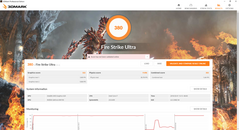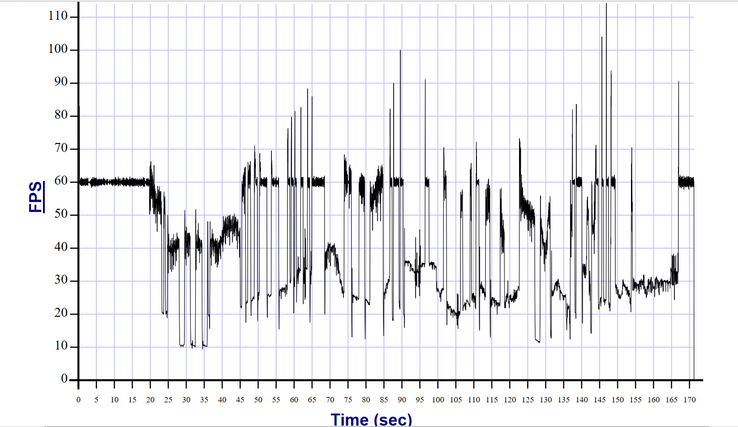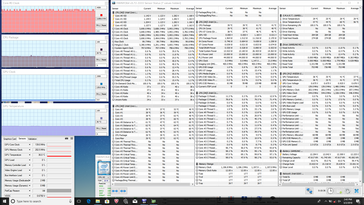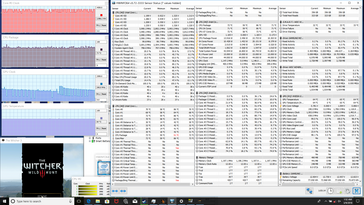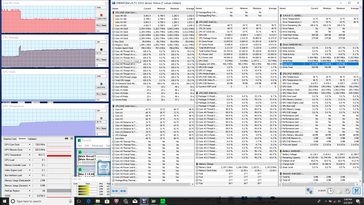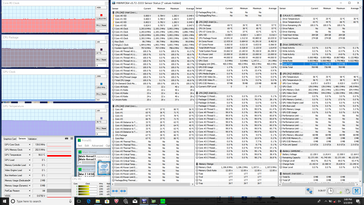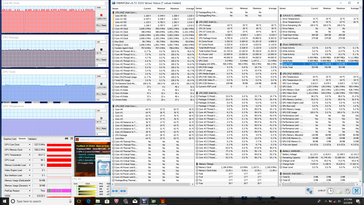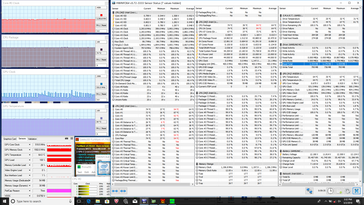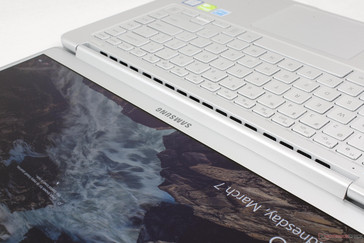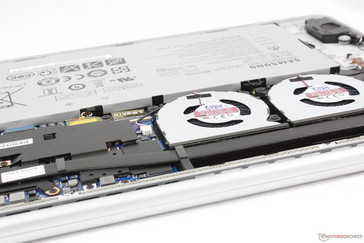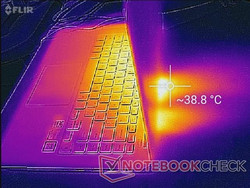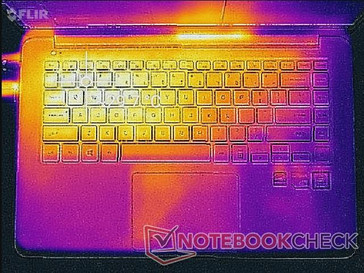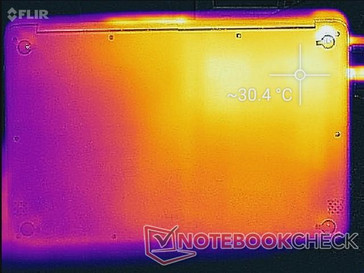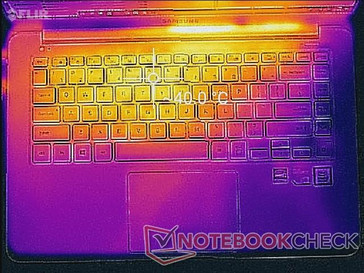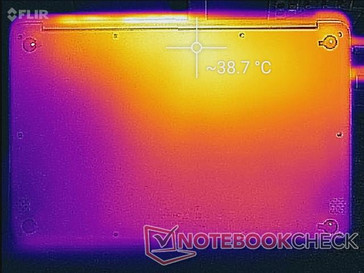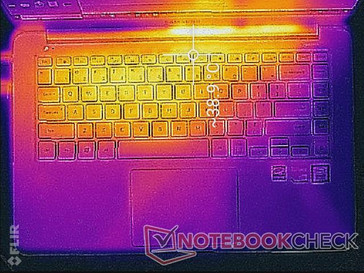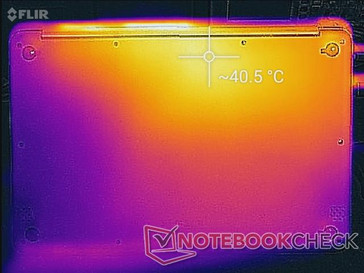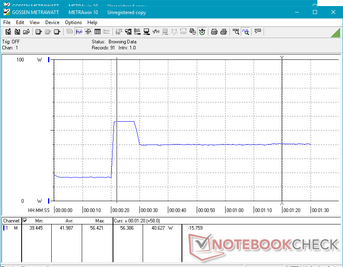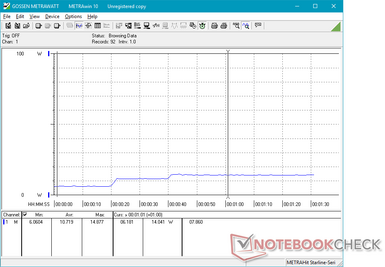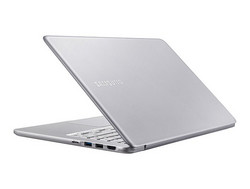Samsung Notebook 9 NP900X5T (i7-8550U, GeForce MX150) Laptop Review

Now that both Kaby Lake-R and entry-level Pascal are available for notebooks, a number of manufacturers have been updating some older Kaby Lake and Maxwell configurations with the latest generation of Intel and Nvidia processors. The Samsung Notebook 9 NP900X5T is one such example as it is an internal update of the outgoing NP900X5N. Whereas last year's model is equipped with a Core i7-7500U CPU and GeForce 940MX GPU, our review model today uses the Core i7-8550U and GeForce MX150. Do these seemingly minor changes make the super-light Samsung any more appealing?
Other than the processor upgrades mentioned above, the NP900X5T utilizes the exact same chassis as the NP900X5N and we recommend checking out our existing review on the notebook for more information and comments on the chassis, display, keyboard, serviceability, and more. For this review, we will be focusing on the performance of the new processors and how it compares to the older configuration.
Notable competitors to the $1500 USD Notebook 9 NP900X5N include the Dell XPS 15, HP Spectre x360 15, LG Gram 15, and MacBook Pro 15. It's important to note that its 15.0-inch screen size is uncommon as most notebooks in this size category have slightly larger 15.6-inch displays.
Case
The 15-inch Samsung Notebook 9 continues to be one of the lightest Ultrabooks in its size class at just under 1.3 kg whereas most 15-inch flagships like the XPS 15, MacBook Pro 15, and Microsoft Surface Book 2 15 are roughly 50 percent heavier at about 2 kg each. Even the smaller and denser XPS 13 9360 is slightly heavier than our Samsung. The LG Gram 15 is noticeably lighter at almost 1 kg, but it's not without some major drawbacks.
The light weight lends itself to an eye-catching marketing blurb at the cost of a more flexible chassis. While Samsung advertises the NP900X5T with a full-body magnesium alloy, surfaces still flex and bend much more so than on the MacBook Pro 15, Razer Blade, Spectre x360 15, or XPS 15. This is especially true of the lid as the Samsung notebook is still lacking a Gorilla Glass overlay that most newer Ultrabooks integrate. Furthermore, the rigidity of the bar hinge is only average and is not uniform. For example, the hinge becomes noticeably weaker when the lid passes 130 degrees or so, which we find unacceptable for a laptop in this price range. Users who want a stronger and sounder notebook may want to consider the heavier alternatives mentioned above.
Connectivity
Available ports and their relative placements have not changed from the NP900X5N including the all-important Thunderbolt 3 port. We're still disappointed to see no Kensington Lock, but users can still charge the notebook via Thunderbolt 3 in place of the AC adapter port if desired.
SD Card Reader
Much like the recent XPS 13 9370, Samsung utilizes a spring-loaded MicroSD reader instead of the more common full-size SD variant. Transfer rates cap out at about 90 MB/s and so moving 1 GB worth of photos from a UHS-II MicroSD card to desktop will take just over 13 seconds.
A fully inserted MicroSD card sits flush against the edge of the notebook for safe transporting. As a consequence, ejecting the card may prove to be difficult for larger hands.
| SD Card Reader | |
| average JPG Copy Test (av. of 3 runs) | |
| HP Spectre x360 15t-bl100 (Toshiba Exceria Pro SDXC 64 GB UHS-II) | |
| Dell XPS 15 9560 (i7-7700HQ, UHD) (Toshiba Exceria Pro SDXC 64 GB UHS-II) | |
| Average of class Multimedia (19.3 - 198, n=43, last 2 years) | |
| Samsung Notebook 9 NP900X5T-X01US (Toshiba Exceria Pro M501 UHS-II) | |
| maximum AS SSD Seq Read Test (1GB) | |
| Dell XPS 15 9560 (i7-7700HQ, UHD) (Toshiba Exceria Pro SDXC 64 GB UHS-II) | |
| HP Spectre x360 15t-bl100 (Toshiba Exceria Pro SDXC 64 GB UHS-II) | |
| Average of class Multimedia (27.4 - 262, n=43, last 2 years) | |
| Samsung Notebook 9 NP900X5T-X01US (Toshiba Exceria Pro M501 UHS-II) | |
Communication
The Intel 8265 returns with Bluetooth 4.2 and wireless-ac connectivity of up to 867 Mbps. We are able to measure a real-world average transfer rate of 668 Mbps when connected to our Linksys EA8500 test router with no unexpected disconnects.
No 4G LTE or GPS options are available.
| Networking | |
| iperf3 transmit AX12 | |
| Dell XPS 15 9560 (i7-7700HQ, UHD) | |
| Microsoft Surface Book 2 15 | |
| Samsung Notebook 9 NP900X5T-X01US | |
| iperf3 receive AX12 | |
| Samsung Notebook 9 NP900X5T-X01US | |
| Dell XPS 15 9560 (i7-7700HQ, UHD) | |
| Microsoft Surface Book 2 15 | |
Accessories
Included extras are a warranty card, Quick Start guide, and a USB Type-C to Micro-USB adapter. This is the first time we've seen such an adapter thrown in for free with a laptop, but it's welcomed nonetheless. Perhaps a USB Type-C charger or USB Type-C to DisplayPort and RJ-45 adapter would have been more useful depending on the user.
Maintenance
Warranty
The standard one-year limited warranty applies if purchased in North America. Dead pixels and bright pixels are covered depending on the number of occurrences.
Input Devices
Keyboard and Touchpad
Our comments on the backlit keyboard and trackpad for the NP900X5N apply here on the NP900X5T. In short, the keyboard offers a uniform 1.5 mm keystroke and a slightly firmer typing experience than on the XPS 15. Clatter is comparatively louder than the Dell and the Arrow keys are still finicky because of their diminutive size. We find that the Spectre x360 15 series and ThinkPad Precision keyboard series offer an even firmer typing experience since their keyboard bases are more rigid and unyielding compared to the Samsung.
The smooth trackpad (11.0 x 8.0 cm) is similar in size to the one on the XPS 15 (10.5 x 8.5 cm) and larger than on the LG Gram 15 (10.3 x 6.9 cm). While cursor tracking is smooth and reliable, the integrated click keys could have benefited from deeper travel and firmer feedback.
Display
The NP900X5T uses the exact same NV150FHB-N31 IPS panel from manufacturer BOE Display as does the last generation NP900X5N. Thus, our measurements for brightness, contrast, gamut, and response times for the NP900X5T are all very similar to what we've recorded for the NP900X5N. Core attributes like contrast and color are where we expect them to be for a high-end Ultrabook at over 1000:1 and almost 100 percent of the sRGB spectrum, respectively. Interestingly, the screen on our unit is not as well-calibrated out of the box as our NP900X5N, although this can be easily addressed by applying our calibrated ICC file below. Subjectively, texts and images are crisp and seemingly pop since there is no thick glass overlay separating the pixels from the panel surface.
The notebook's signature feature continues to be "Outdoor mode" that, when activated, can bump screen brightness up to a measured 558 nits. If disabled, the maximum brightness setting will "only" be about 389 nits. When considering that most 15-inch Ultrabooks top out at under 300 or 400 nits, Samsung's Outdoor mode can be very useful in outdoor conditions where ambient lighting often overwhelm the screen.
All measurements below were performed with Outdoor mode enabled. Note that pulse-width modulation was detected on brightness levels under 91 percent, but the high frequency shouldn't affect most users. Backlight bleeding is surprisingly minimal when taking into account the very bright backlight.
| |||||||||||||||||||||||||
Brightness Distribution: 92 %
Center on Battery: 558.2 cd/m²
Contrast: 1213:1 (Black: 0.46 cd/m²)
ΔE ColorChecker Calman: 4.41 | ∀{0.5-29.43 Ø4.83}
ΔE Greyscale Calman: 6.6 | ∀{0.09-98 Ø5.1}
97.2% sRGB (Argyll 1.6.3 3D)
61.3% AdobeRGB 1998 (Argyll 1.6.3 3D)
66.8% AdobeRGB 1998 (Argyll 3D)
97.4% sRGB (Argyll 3D)
65.2% Display P3 (Argyll 3D)
Gamma: 2.19
CCT: 7615 K
| Samsung Notebook 9 NP900X5T-X01US ID: BOE06E8, Name: BOE HF NV150FHB-N31, IPS, 15", 1920x1080 | Dell XPS 15 9560 (i7-7700HQ, UHD) IGZO IPS, 15.6", 3840x2160 | LG Gram 15Z975 ID: LGD052A, Name: LG Philips LP156WFA-SPC1, IPS, 15.6", 1920x1080 | Apple MacBook Pro 15 2017 (2.9 GHz, 560) 15.4", 2880x1800 | Microsoft Surface Book 2 15 LG Philips LGD0554, IPS, 15", 3240x2160 | Samsung Notebook 9 NP900X5N-X01US ID: BOE06E8, Name: BOE HF NV150FHB-N31, IPS, 15", 1920x1080 | |
|---|---|---|---|---|---|---|
| Display | 30% | -18% | 0% | |||
| Display P3 Coverage | 65.2 | 89.7 38% | 54.9 -16% | 65.2 0% | ||
| sRGB Coverage | 97.4 | 100 3% | 77.1 -21% | 97.7 0% | ||
| AdobeRGB 1998 Coverage | 66.8 | 100 50% | 56.3 -16% | 67.2 1% | ||
| Response Times | -28% | 19% | 7% | 21% | 1% | |
| Response Time Grey 50% / Grey 80% * | 46 ? | 57.2 ? -24% | 35.2 ? 23% | 42.4 ? 8% | 37.6 ? 18% | 40.8 ? 11% |
| Response Time Black / White * | 29.6 ? | 39.2 ? -32% | 25.6 ? 14% | 28 ? 5% | 22.4 ? 24% | 32.4 ? -9% |
| PWM Frequency | 2976 ? | 962 | 21930 ? | 208.3 ? | ||
| Screen | -0% | -12% | 28% | 26% | 16% | |
| Brightness middle | 558.2 | 370.1 -34% | 273 -51% | 534 -4% | 446 -20% | 565.6 1% |
| Brightness | 528 | 356 -33% | 276 -48% | 502 -5% | 444 -16% | 524 -1% |
| Brightness Distribution | 92 | 87 -5% | 89 -3% | 86 -7% | 89 -3% | 88 -4% |
| Black Level * | 0.46 | 0.37 20% | 0.22 52% | 0.31 33% | 0.25 46% | 0.49 -7% |
| Contrast | 1213 | 1000 -18% | 1241 2% | 1723 42% | 1784 47% | 1154 -5% |
| Colorchecker dE 2000 * | 4.41 | 5.3 -20% | 4.77 -8% | 1.8 59% | 1.7 61% | 2 55% |
| Colorchecker dE 2000 max. * | 10.91 | 9.9 9% | 10.76 1% | 3.8 65% | 2.7 75% | 5 54% |
| Greyscale dE 2000 * | 6.6 | 4.6 30% | 8.6 -30% | 2.4 64% | 1.7 74% | 2.5 62% |
| Gamma | 2.19 100% | 2.31 95% | 1.7 129% | 2.27 97% | 2.11 104% | 2.21 100% |
| CCT | 7615 85% | 6284 103% | 6678 97% | 6563 99% | 6384 102% | 6896 94% |
| Color Space (Percent of AdobeRGB 1998) | 61.3 | 88.3 44% | 50.2 -18% | 77.92 27% | 58.6 -4% | 61.2 0% |
| Color Space (Percent of sRGB) | 97.2 | 100 3% | 76.9 -21% | 99.94 3% | 92.9 -4% | 97.5 0% |
| Total Average (Program / Settings) | 1% /
2% | -4% /
-9% | 18% /
24% | 24% /
25% | 6% /
11% |
* ... smaller is better
Color space is approximately 97 percent and 61 percent of the sRGB and AdobeRGB standards, respectively. Amateur digital artists will appreciate the wide sRGB coverage while users looking for more accurate colors may want to consider notebooks with Sharp IGZO panels like the XPS 15 or Razer Blade.
Further analyses with a X-Rite spectrophotometer reveal inaccurate grayscale and colors out of the box with Teal in particular being more inaccurate than the other primary and secondary colors. Our calibration attempt corrects these issues for dramatically improved grayscale and colors across all saturation levels with average Delta E values of under 2.0 each. We recommend calibrating the display to get the most accurate colors possible.
Display Response Times
| ↔ Response Time Black to White | ||
|---|---|---|
| 29.6 ms ... rise ↗ and fall ↘ combined | ↗ 16.4 ms rise | |
| ↘ 13.2 ms fall | ||
| The screen shows relatively slow response rates in our tests and may be too slow for gamers. In comparison, all tested devices range from 0.1 (minimum) to 240 (maximum) ms. » 78 % of all devices are better. This means that the measured response time is worse than the average of all tested devices (20.5 ms). | ||
| ↔ Response Time 50% Grey to 80% Grey | ||
| 46 ms ... rise ↗ and fall ↘ combined | ↗ 25.2 ms rise | |
| ↘ 20.8 ms fall | ||
| The screen shows slow response rates in our tests and will be unsatisfactory for gamers. In comparison, all tested devices range from 0.165 (minimum) to 636 (maximum) ms. » 77 % of all devices are better. This means that the measured response time is worse than the average of all tested devices (32.1 ms). | ||
Screen Flickering / PWM (Pulse-Width Modulation)
| Screen flickering / PWM detected | 2976 Hz | ≤ 91 % brightness setting | |
The display backlight flickers at 2976 Hz (worst case, e.g., utilizing PWM) Flickering detected at a brightness setting of 91 % and below. There should be no flickering or PWM above this brightness setting. The frequency of 2976 Hz is quite high, so most users sensitive to PWM should not notice any flickering. In comparison: 53 % of all tested devices do not use PWM to dim the display. If PWM was detected, an average of 8327 (minimum: 5 - maximum: 343500) Hz was measured. | |||
Outdoor visibility is excellent and one of the best in the 15-inch Ultrabook category because of Samsung's "Outdoor mode" feature. When activated, the screen will be even brighter than the MacBook Pro 15 set to its maximum brightness setting. Texts and images are easy to see when under shade and on cloudy days, but direct sunlight should still be avoided.
Glare is present since there is no matte option. As stated in our review of the NP900X5N, we find this to be unconventional because the notebook includes no touchscreen options at all.
Performance
The NP900X5T is currently available in two SKUs. The lower-end configuration ships with an i7-8550U CPU, integrated HD Graphics 620 GPU, 8 GB of RAM, and 256 GB of storage while the higher-end unit ships with an i7-8550U CPU, dedicated GeForce MX150 graphics and Optimus, 16 GB of RAM, and 256 GB of storage. The costlier option is only $200 USD more for a very large boost in GPU performance as we will show below.
Processor
CPU performance from the Core i7-8550U is in line with other notebooks sporting the same processor. Owners can expect a 12 percent to 60 percent boost in raw power over the i7-7500U in the older Notebook 9 depending on the application and number of simultaneous threads. The notebook is unable to maintain maximum Turbo Boost for very long, however, as our CineBench R15 Multi-Thread loop test below shows. Final scores drop by about 5.5 percent immediately following the first run in the loop. Fortunately, home users are not likely to notice the small performance dip during day-to-day activities.
See our dedicated Core i7-8550U page for more technical details and benchmark comparisons.
* ... smaller is better
System Performance
PCMark benchmarks rank the NP900X5T just a few percentage points higher than the NP900X5N and most other Ultrabooks in this price range. As a result, the Samsung won't feel significantly faster or smoother than other SSD-based Ultrabooks when launching common applications or browsing the web despite the hardware upgrades over the previous generation. We encountered no notable software or hardware issues during our time with the test unit.
| PCMark 10 - Score | |
| Samsung Notebook 9 NP900X5T-X01US | |
| HP Spectre x360 15t-bl100 | |
| Average Intel Core i7-8550U, NVIDIA GeForce MX150 (3056 - 4106, n=19) | |
| LG Gram 15Z975 | |
| PCMark 8 Home Score Accelerated v2 | 4130 points | |
| PCMark 8 Creative Score Accelerated v2 | 5325 points | |
| PCMark 8 Work Score Accelerated v2 | 5228 points | |
| PCMark 10 Score | 4106 points | |
Help | ||
Storage Devices
Internal storage is limited to a single M.2 2280 slot. Our NP900X5T is equipped with the same 256 GB Samsung PM961 NVMe SSD as last year's model which shouldn't be surprising considering the manufacturer. Transfer rates are significantly faster than SATA III SSDs found on cheaper notebooks and on par with the Lite-On CX2-8B512 found on the XPS 15. Samsung is not currently shipping SKUs with other storage capacities in the U.S., but owners can thankfully upgrade themselves if desired.
See our table of SSDs and HDDs for more benchmark comparisons.
| Samsung Notebook 9 NP900X5T-X01US Samsung PM961 MZVLW256HEHP | Dell XPS 15 9560 (i7-7700HQ, UHD) Lite-On CX2-8B512-Q11 | Samsung Notebook 9 NP900X5N-X01US Samsung PM961 MZVLW256HEHP | LG Gram 15Z975 SK Hynix HFS256G39TND-N210A | HP Spectre x360 15t-bl100 Samsung PM961 NVMe MZVLW512HMJP | |
|---|---|---|---|---|---|
| AS SSD | 4% | 20% | -103% | 40% | |
| Copy Game MB/s | 1058 | 540 -49% | 648 -39% | 179.8 -83% | 1134 7% |
| Copy Program MB/s | 479.5 | 411.5 -14% | 497.9 4% | 141.2 -71% | 534 11% |
| Copy ISO MB/s | 1751 | 1272 -27% | 1685 -4% | 197.5 -89% | 1936 11% |
| Score Total | 2646 | 2810 6% | 3906 48% | 1003 -62% | 3781 43% |
| Score Write | 628 | 1022 63% | 928 48% | 339 -46% | 1556 148% |
| Score Read | 1367 | 1206 -12% | 2011 47% | 442 -68% | 1493 9% |
| Access Time Write * | 0.032 | 0.034 -6% | 0.03 6% | 0.232 -625% | 0.026 19% |
| Access Time Read * | 0.054 | 0.034 37% | 0.043 20% | 0.08 -48% | 0.04 26% |
| 4K-64 Write | 392.6 | 789 101% | 674 72% | 246.7 -37% | 1262 221% |
| 4K-64 Read | 1085 | 962 -11% | 1709 58% | 366.5 -66% | 1206 11% |
| 4K Write | 115 | 112.2 -2% | 124.1 8% | 67.6 -41% | 141.1 23% |
| 4K Read | 48.71 | 41.34 -15% | 48.71 0% | 26.24 -46% | 51.9 7% |
| Seq Write | 1206 | 1207 0% | 1299 8% | 248.5 -79% | 1530 27% |
| Seq Read | 2337 | 2026 -13% | 2533 8% | 488.1 -79% | 2342 0% |
* ... smaller is better
GPU Performance
The GeForce MX150 in our Samsung is about 2x to 2.5x faster than the GeForce 940MX in last year's model or 3x to 5x faster than the integrated HD Graphics 620 according to 3DMark benchmarks. Thus, users who may be considering the lower-end NP900X5T SKU with only integrated graphics will be foregoing a significant amount of graphics power. Older mainstream gaming notebooks with the GTX 960M can still outperform the MX150 by about 20 to 30 percent, but these notebooks are also much heavier and thicker than our Samsung.
Unfortunately, gaming performance is horrendous on the Samsung. While synthetic 3DMark scores are where we expect them to be for the GeForce MX150, performance in real-world games is much slower than other notebooks equipped with the same GPU. Prey, for example, runs at an average of 10 FPS at maximum 1080p settings compared to 28 FPS on the Acer Aspire 5 A515. The discrepancy is due to periodic throttling of the GPU as our Stress Test section below will detail. Frame rates would consistently dip every few seconds for a very short amount of time and the recorded averages are subsequently very low. Our Metro: Last Light frame rate graph below illustrates this perfectly.
Additionally, the notebook appears to cap the frame rate at 60 FPS for nearly all games despite disabling V-Sync, enabling every "High Performance" setting we can find, updating to the latest Nvidia drivers (391.01) and Windows Updates, and rerunning benchmarks to confirm our findings. We're not sure what software or potential proprietary limitations are in place, but these constant frame dips make most titles unplayable.
See our dedicated page on the GeForce MX150 for more technical information and gaming benchmarks.
| 3DMark 11 Performance | 4642 points | |
| 3DMark Ice Storm Standard Score | 46087 points | |
| 3DMark Cloud Gate Standard Score | 13207 points | |
| 3DMark Fire Strike Score | 3104 points | |
| 3DMark Fire Strike Extreme Score | 1595 points | |
Help | ||
| low | med. | high | ultra | |
|---|---|---|---|---|
| BioShock Infinite (2013) | 132.2 | 60 | 59.7 | 30.9 |
| Metro: Last Light (2013) | 53.4 | 41.6 | 36.3 | 17.2 |
| Thief (2014) | 58 | 32.5 | 31.1 | 18.8 |
| The Witcher 3 (2015) | 46.8 | 33.7 | 20.5 | 11 |
| Batman: Arkham Knight (2015) | 41 | 36 | 20 | |
| Metal Gear Solid V (2015) | 60 | 50.9 | 37.2 | 23.2 |
| Fallout 4 (2015) | 55 | 34.5 | 18.6 | 17.4 |
| Rise of the Tomb Raider (2016) | 60.9 | 35.4 | 19.2 | 16.4 |
| Ashes of the Singularity (2016) | 25.2 | 16.2 | 14.1 | |
| Overwatch (2016) | 60 | 60 | 46.1 | 27.5 |
| Prey (2017) | 50.6 | 19.2 | 14 | 10.5 |
| F1 2017 (2017) | 55 | 24 | 19 | 14 |
| Middle-earth: Shadow of War (2017) | 47 | 21 | 15 | 11 |
| Destiny 2 (2017) | 29.1 | 10.8 |
Stress Test
We stress the notebook with unrealistic benchmark loads to test for any potential throttling or stability issues. When subjected to Prime95 loads, the CPU can be observed operating at up to 3.7 GHz for only the first few seconds before core temperature reaches 80 C and clock rates drop to a steady 2.3 GHz. Thus, maximum Turbo Boost potential is very short-lived and the results corroborate with our CineBench loop tests from above. The steady 2.3 GHz clock rate is still faster than the base 1.8 GHz clock rate of the i7-8550U CPU, so we can appreciate that the notebook can maintain at least a portion of the processor's Turbo Boost when under extreme loads.
Running both Prime95 and FurMark simultaneously to stress the CPU and GPU will see the processors plateau at respectable core temperatures of 74 C and 64 C, respectively. Users can expect both processors to run below 70 C each when gaming whereas the similarly-equipped Spectre x360 15 will run slightly warmer in the mid-to-high 70 C range when under similar conditions.
Results become more curious when running Witcher 3 to represent real-world gaming loads. The GPU inexplicably fluctuates between clock rates as low as ~240 MHz to ~840 MHz with uneven frame rates as a result. The findings line up with our gaming benchmarks above where values are much lower than expected for a GeForce MX150. Such massive fluctuations may be purposefully imposed in order to keep core temperatures in check, but we can observe no temperature benefits or advantages from this extreme level of throttling.
Running on batteries will entail a slight performance cut to the CPU and GPU. A 3DMark 11 run on batteries returns Physics and Graphics scores of 7547 and 4242 points, respectively, compared to 8093 and 4369 points when on mains.
| CPU Clock (GHz) | GPU Clock (MHz) | Average CPU Temperature (°C) | Average GPU Temperature (°C) | |
| Prime95 Stress | 2.3 | -- | 67 | 56 |
| FurMark Stress | -- | 1228 | 65 | 64 |
| Prime95 + FurMark Stress | 2.3 | 202 - 848 | 74 | 64 |
| Witcher 3 Stress | ~3.6 - 3.9 | 240 - 840 | ~73 | 64 |
Emissions
System Noise
Fan noise and behavior are essentially identical to the NP900X5N. The notebook is quiet (but not silent) when under low loads like word processing or video streaming at up to 32 dB(A) at worst. Users can expect nothing more than a slow and constant whir since the fans do not pulse.
Medium loads or higher will bump fan noise up to 40 dB(A) to be quieter than the XPS 15 when under similar conditions. The noise is not intolerable when gaming, but others nearby will still take notice in quieter environments like libraries.
Very light coil whine is present when placing an ear next to the keyboard keys. Fortunately, it's very minor and unnoticeable when typing from a normal sitting distance.
Noise Level
| Idle |
| 29.6 / 29.6 / 30.3 dB(A) |
| Load |
| 40 / 40 dB(A) |
 | ||
30 dB silent 40 dB(A) audible 50 dB(A) loud |
||
min: | ||
| Samsung Notebook 9 NP900X5T-X01US GeForce MX150, i5-8550U, Samsung PM961 MZVLW256HEHP | Dell XPS 15 9560 (i7-7700HQ, UHD) GeForce GTX 1050 Mobile, i7-7700HQ, Lite-On CX2-8B512-Q11 | Samsung Notebook 9 NP900X5N-X01US GeForce 940MX, i7-7500U, Samsung PM961 MZVLW256HEHP | LG Gram 15Z975 UHD Graphics 620, i5-8250U, SK Hynix HFS256G39TND-N210A | HP Spectre x360 15t-bl100 GeForce MX150, i5-8550U, Samsung PM961 NVMe MZVLW512HMJP | |
|---|---|---|---|---|---|
| Noise | -9% | 5% | 6% | 3% | |
| off / environment * | 29.6 | 28.4 4% | 28.3 4% | 29.2 1% | 28.4 4% |
| Idle Minimum * | 29.6 | 29 2% | 28.3 4% | 29.2 1% | 28.4 4% |
| Idle Average * | 29.6 | 29 2% | 28.3 4% | 29.2 1% | 28.4 4% |
| Idle Maximum * | 30.3 | 32.2 -6% | 28.3 7% | 29.2 4% | 28.4 6% |
| Load Average * | 40 | 47.1 -18% | 38.3 4% | 32.5 19% | 41.6 -4% |
| Witcher 3 ultra * | 40 | 52 -30% | 36.1 10% | ||
| Load Maximum * | 40 | 47.1 -18% | 38.3 4% | 37.2 7% | 41.6 -4% |
* ... smaller is better
Temperature
Surface temperatures when idling are warmer than the outgoing NP900X5N when under similar conditions. The left half of the notebook will always be warmer than the right simply due to the positioning of the processors within. While the temperature delta between the bottom right and top left corners of the keyboard can be as much as 5 C, the system will not grow uncomfortably warm for low processing loads like word processing or email.
Higher loads like gaming will cause surface temperatures around the rear of the unit to grow as warm as 40 C not unlike on the NP500X5N. The palm rests remain cool, but the temperature difference between the left and right sides of the keyboard will be more noticeable. Competing notebooks like the XPS 15 and Spectre x360 15 can be as hot as 50 C when under similar gaming loads, so the Samsung is acceptably warm overall given its graphics performance and smaller size.
(+) The maximum temperature on the upper side is 39 °C / 102 F, compared to the average of 36.9 °C / 98 F, ranging from 21.1 to 71 °C for the class Multimedia.
(±) The bottom heats up to a maximum of 40.4 °C / 105 F, compared to the average of 39.2 °C / 103 F
(+) In idle usage, the average temperature for the upper side is 26.6 °C / 80 F, compared to the device average of 31.3 °C / 88 F.
(±) Playing The Witcher 3, the average temperature for the upper side is 32.7 °C / 91 F, compared to the device average of 31.3 °C / 88 F.
(+) The palmrests and touchpad are cooler than skin temperature with a maximum of 28.4 °C / 83.1 F and are therefore cool to the touch.
(±) The average temperature of the palmrest area of similar devices was 28.7 °C / 83.7 F (+0.3 °C / 0.6 F).
Speakers
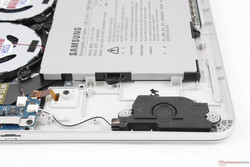
The stereo 2 W speakers are average given the small size of the notebook, but they are otherwise below average for the high starting price. Speakers on competing Ultrabooks like the XPS 15 or Spectre x360 15 have louder internal audio and deeper bass reproduction for better video and music playback. Setting the volume to maximum will not induce any rattling or major chassis reverberations. 3.5 mm external solutions are still recommend during extended media playback sessions or conferences.
Samsung Notebook 9 NP900X5T-X01US audio analysis
(-) | not very loud speakers (64.5 dB)
Bass 100 - 315 Hz
(-) | nearly no bass - on average 21.3% lower than median
(±) | linearity of bass is average (12.6% delta to prev. frequency)
Mids 400 - 2000 Hz
(+) | balanced mids - only 3.4% away from median
(+) | mids are linear (4.2% delta to prev. frequency)
Highs 2 - 16 kHz
(+) | balanced highs - only 3.3% away from median
(±) | linearity of highs is average (9.3% delta to prev. frequency)
Overall 100 - 16.000 Hz
(±) | linearity of overall sound is average (25.1% difference to median)
Compared to same class
» 88% of all tested devices in this class were better, 3% similar, 8% worse
» The best had a delta of 5%, average was 18%, worst was 45%
Compared to all devices tested
» 75% of all tested devices were better, 5% similar, 19% worse
» The best had a delta of 4%, average was 24%, worst was 134%
Apple MacBook 12 (Early 2016) 1.1 GHz audio analysis
(+) | speakers can play relatively loud (83.6 dB)
Bass 100 - 315 Hz
(±) | reduced bass - on average 11.3% lower than median
(±) | linearity of bass is average (14.2% delta to prev. frequency)
Mids 400 - 2000 Hz
(+) | balanced mids - only 2.4% away from median
(+) | mids are linear (5.5% delta to prev. frequency)
Highs 2 - 16 kHz
(+) | balanced highs - only 2% away from median
(+) | highs are linear (4.5% delta to prev. frequency)
Overall 100 - 16.000 Hz
(+) | overall sound is linear (10.2% difference to median)
Compared to same class
» 6% of all tested devices in this class were better, 2% similar, 91% worse
» The best had a delta of 5%, average was 19%, worst was 53%
Compared to all devices tested
» 4% of all tested devices were better, 1% similar, 95% worse
» The best had a delta of 4%, average was 24%, worst was 134%
Frequency Comparison (Checkbox selectable!)
Graph 1: Pink Noise 100% Vol.; Graph 2: Audio off
Energy Management
Power Consumption
The system will draw anywhere between 3 W to 14 W when idling on desktop depending on the power profile and screen brightness. This range is slightly wider than most 15-inch Ultrabooks due to the extra-bright "Outdoor mode" setting that is responsible for an additional ~2 W consumption over the "standard" maximum brightness setting.
Gaming loads will demand about 50 W to 53 W or about half of what a GTX 1050-powered gaming notebook will draw when under similar conditions. Note that the last generation 15-inch Notebook 9 with the older GeForce 940MX draws very nearly the same Wattage as our MX150-powered version when gaming while providing half the graphics performance. The gain in performance-per-Watt is massive when jumping from Maxwell-based notebooks to the current Pascal generation.
Maximum load with Prime95 and FurMark running simultaneously will demand about 56 W from a small (~6 x 6 x 2 cm) 65 W AC adapter.
| Off / Standby | |
| Idle | |
| Load |
|
Key:
min: | |
| Samsung Notebook 9 NP900X5T-X01US i5-8550U, GeForce MX150, Samsung PM961 MZVLW256HEHP, IPS, 1920x1080, 15" | Dell XPS 15 9560 (i7-7700HQ, UHD) i7-7700HQ, GeForce GTX 1050 Mobile, Lite-On CX2-8B512-Q11, IGZO IPS, 3840x2160, 15.6" | Samsung Notebook 9 NP900X5N-X01US i7-7500U, GeForce 940MX, Samsung PM961 MZVLW256HEHP, IPS, 1920x1080, 15" | LG Gram 15Z975 i5-8250U, UHD Graphics 620, SK Hynix HFS256G39TND-N210A, IPS, 1920x1080, 15.6" | HP Envy x360 15m-bq121dx R5 2500U, Vega 8, HGST Travelstar 7K1000 HTS721010A9E630, IPS, 1920x1080, 15.6" | Microsoft Surface Laptop i7 i7-7660U, Iris Plus Graphics 640, Samsung PM971 KUS040202M, IPS, 2256x1504, 13.5" | |
|---|---|---|---|---|---|---|
| Power Consumption | -103% | -4% | 19% | 3% | 32% | |
| Idle Minimum * | 3.5 | 11.9 -240% | 5 -43% | 4.4 -26% | 5.9 -69% | 2.7 23% |
| Idle Average * | 11.3 | 17.1 -51% | 11.6 -3% | 9.1 19% | 8.7 23% | 7.6 33% |
| Idle Maximum * | 14.2 | 17.3 -22% | 12.2 14% | 9.6 32% | 10.5 26% | 7.8 45% |
| Load Average * | 53.3 | 94.7 -78% | 47.8 10% | 34.8 35% | 45.7 14% | 37.5 30% |
| Witcher 3 ultra * | 50.6 | 104.8 -107% | 51.9 -3% | 45.8 9% | 31.7 37% | |
| Load Maximum * | 56.2 | 122 -117% | 55.7 1% | 36 36% | 49.4 12% | 41.6 26% |
* ... smaller is better
Battery Life
Samsung quietly bumped the battery capacity from 66 Wh on the older NP900X5N to 75 Wh on the NP900X5T. Battery life is already very long on the outgoing model and since the i7-8550U/MX150 combo isn't significantly more power demanding than the i7-7500U/940MX, the increase in capacity should lead to an increase in runtime for the NP900X5T. Our test results prove this to be the case for all three conditions as shown by the table below. Users can expect about 10.5 hours of real-world WLAN use when on the Balanced profile setting and a screen brightness of 150 nits (or 60 percent). Competing notebooks in this size category tend to last a few hours shorter.
Charging from near empty to full capacity will take about 2 to 2.5 hours. Unfortunately, Samsung does not throw in a USB Type-C charger in the packaging.
| Samsung Notebook 9 NP900X5T-X01US i5-8550U, GeForce MX150, 75 Wh | Dell XPS 15 9560 (i7-7700HQ, UHD) i7-7700HQ, GeForce GTX 1050 Mobile, 97 Wh | Samsung Notebook 9 NP900X5N-X01US i7-7500U, GeForce 940MX, 66 Wh | LG Gram 15Z975 i5-8250U, UHD Graphics 620, 60 Wh | HP Spectre x360 15t-bl100 i5-8550U, GeForce MX150, 79.2 Wh | HP Envy x360 15m-bq121dx R5 2500U, Vega 8, 55.8 Wh | |
|---|---|---|---|---|---|---|
| Battery Runtime | -35% | -8% | -23% | -20% | -47% | |
| Reader / Idle | 1810 | 831 -54% | 1642 -9% | 1078 -40% | 934 -48% | 655 -64% |
| WiFi v1.3 | 635 | 434 -32% | 604 -5% | 435 -31% | 511 -20% | 398 -37% |
| Load | 127 | 103 -19% | 116 -9% | 131 3% | 136 7% | 77 -39% |
Pros
Cons
Verdict
We mentioned in our review of the NP900X5N that it would be unwise to purchase the configuration since both Kaby Lake-R and mainstream Pascal were rumored to be just over the hill. Now that both are finally available, patient users can now enjoy an approximate 60 percent CPU boost and 115 percent GPU boost over the i7-7500U and GeForce 940MX in the older model. This becomes even more impressive when considering that the latest model doesn't run any louder, warmer, or shorter because of its improved performance-per-Watt. The larger capacity battery in particular is a surprise since runtimes on last year's model was already above average.
The biggest drawback is the heavy GPU throttling when gaming. It's strange to record normal synthetic benchmark scores only to find abhorrent gaming performance and widely fluctuating frame rates. Until we hear from Samsung on the issue or an appropriate update is released, we cannot recommend the pricier SKU with the MX150.
Everything else about the notebook remains unchanged for better or worse. The Notebook 9 is still uncontested for users who want the lightest and brightest 15-inch Ultrabook for unladen use when on the go. On the other side of the spectrum, case rigidity takes a hard hit and users will lose out on 2-in-1 and touchscreen options that systems like the Spectre series can deliver. We're eager to see a complete refresh of the Notebook 9 series as we think Samsung can make it even better by dropping the proprietary AC charging port for universal USB Type-C charging, merging the fingerprint reader with the Power button, and integrating eSIM to bolster the portability of the system.
Be very cautious if purchasing the MX150 SKU due to GPU throttling when gaming. The more affordable SKU with only integrated graphics is still an excellent buy for users who want something larger than the XPS 13 but lighter, brighter, and more compact than the XPS 15.
Samsung Notebook 9 NP900X5T-X01US
- 03/13/2018 v6 (old)
Allen Ngo




